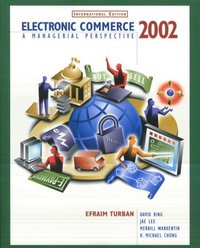Electronic Commerce 2002: A Managerial Perspective, 2/e (IE-Paperback)
暫譯: 電子商務 2002:管理視角,第二版 (IE-平裝本)
Efraim Turban
- 出版商: Prentice Hall
- 出版日期: 2002-01-14
- 定價: $820
- 售價: 2.4 折 $199
- 語言: 英文
- 頁數: 960
- ISBN: 0130984256
- ISBN-13: 9780130984258
-
相關分類:
管理與領導 Management-leadership、行銷/網路行銷 Marketing、電子商務 E-commerce
立即出貨(限量) (庫存=1)
買這商品的人也買了...
-
 Computer Organization & Design: The Hardware/Software Interface, 2/e
Computer Organization & Design: The Hardware/Software Interface, 2/e$1,200$1,176 -
 計算機組織與設計--軟硬體界面第二版 (Computer Organization & Design, 2/e)
計算機組織與設計--軟硬體界面第二版 (Computer Organization & Design, 2/e)$680$578 -
 Data Mining: Concepts and Techniques
Data Mining: Concepts and Techniques$2,410$2,290 -
 $1,029Fundamentals of Logic Design, 4/e
$1,029Fundamentals of Logic Design, 4/e -
 $970Introduction to Algorithms, 2/e (Hardcover)
$970Introduction to Algorithms, 2/e (Hardcover) -
 Digital Image Processing, 2/e(IE)(美國版ISBN:0201180758)
Digital Image Processing, 2/e(IE)(美國版ISBN:0201180758)$1,150$1,127 -
 $825Cisco CCNA Exam #640-607 Certification Guide, 3/e
$825Cisco CCNA Exam #640-607 Certification Guide, 3/e -
 $1,274Computer Architecture: A Quantitative Approach, 3/e(精裝本)
$1,274Computer Architecture: A Quantitative Approach, 3/e(精裝本) -
 $1,029Operating System Concepts, 6/e (Windows XP Update)
$1,029Operating System Concepts, 6/e (Windows XP Update) -
 演算法導論 (Introduction to Algorithms, 2/e)
演算法導論 (Introduction to Algorithms, 2/e)$860$679 -
 Cryptography and Network Security Principles and Practices, 3/e
Cryptography and Network Security Principles and Practices, 3/e$1,030$1,009 -
 Visual C#.NET 程式設計經典
Visual C#.NET 程式設計經典$650$514 -
 資料結構理論-使用Java
資料結構理論-使用Java$550$429 -
 Understanding the Linux Kernel, 2/e (Paperback)
Understanding the Linux Kernel, 2/e (Paperback)$1,720$1,634 -
 Embedded Software Development with eCos
Embedded Software Development with eCos$1,650$1,568 -
 作業系統概念 (Operating System Concepts, 6/e Windows XP Update)
作業系統概念 (Operating System Concepts, 6/e Windows XP Update)$780$741 -
 資料庫系統原理第三版 (Fundamentals of Database Systems, 3/e)
資料庫系統原理第三版 (Fundamentals of Database Systems, 3/e)$760$646 -
 Red Hat Linux 9 實務應用
Red Hat Linux 9 實務應用$650$553 -
 802.11 無線網路技術通論 (802.11 Wireless Networks: The Definitive Guide)
802.11 無線網路技術通論 (802.11 Wireless Networks: The Definitive Guide)$760$600 -
 STRUTS 實作手冊(Struts in Action: Building Web Applications with the Leading Java Framework)
STRUTS 實作手冊(Struts in Action: Building Web Applications with the Leading Java Framework)$690$538 -
 作業系統
作業系統$650$618 -
 重構─改善既有程式的設計
重構─改善既有程式的設計$720$612 -
 電腦網路 (Computer Networks, 4/e)
電腦網路 (Computer Networks, 4/e)$800$760 -
 鳥哥的 Linux 私房菜─基礎學習篇增訂版
鳥哥的 Linux 私房菜─基礎學習篇增訂版$560$476 -
 Linux 驅動程式 (Linux Device Drivers, 2/e)
Linux 驅動程式 (Linux Device Drivers, 2/e)$880$695
相關主題
商品描述
For one/two-semester courses in Electronic Commerce.
One of the first texts entirely dedicated to EC, this comprehensive, user-friendly text describes what electronic commerce is; how it is being conducted and managed; and its major opportunities, limitations, issues, and risks. With a blend of theory and practical application, this text is structured around the notion that EC applications require certain technological infrastructures and other support mechanisms. It recognizes that e-business has two parts: business and technology.
Table of Contents
I. A REAL REVOLUTION.
Appendix: Supply and value chains.
2. The Digital Economy.
II. B2C EC —INTERNET MARKETING.
4. Internet Consumers, e-Service, and Market Research.
Appendix: CRM.
5. Advertisement in E-Commerce.
III. B2B EC.
Appendix: From Traditional to Internet-Based EDI.
7. E-Marketplaces and B2B Exchanges.
Appendix: The Extranets.
8. B2B Support Services.
IV. OTHER EC MODELS AND APPLICATIONS.
10. Service Industries, Online Publishing, and Knowledge Dissemination.
11. Intrabusiness, e-Government, and More.
V. BUILDING EC SYSTEMS.
Appendix 12A: Building an Application with Yahoo! Store.
13. E-Commerce Security.
14. Electronic Payment Systems.
15. Order Fulfillment, Logistics, and Supply Chain Management.
VI. IMPLEMENTING EC.
17. The Regulatory Environment of Electronic Commerce.
18. E-Communities, Global, and Other Issues in EC.
19. M-Commerce.
Appendices: A. Infrastructure for EC. B. Web Tools, Web Page Design and Creation. C. Web Programming. D. Intelligent Agents. (Located on the Text Website).
商品描述(中文翻譯)
電子商務一/兩學期課程專用書籍之一。這本全面且易於使用的教材詳細描述了電子商務的定義、運作及管理方式,以及其主要的機會、限制、議題和風險。這本書結合了理論與實務應用,結構圍繞著電子商務應用需要特定的技術基礎設施和其他支援機制的概念。它認識到電子商務有兩個部分:商業與技術。
**目錄**
I. 真正的革命。
1. 電子商務概述。
附錄:供應鏈與價值鏈。
2. 數位經濟。
II. B2C 電子商務 — 網路行銷。
3. 電子商務中的零售(e-Tailing)。
4. 網路消費者、電子服務與市場研究。
附錄:客戶關係管理(CRM)。
5. 電子商務中的廣告。
III. B2B 電子商務。
6. 以公司為中心的 B2B。
附錄:從傳統到基於網路的電子數據交換(EDI)。
7. 電子市場與 B2B 交易所。
附錄:外部網路(Extranets)。
8. B2B 支援服務。
IV. 其他電子商務模型與應用。
9. 動態定價:拍賣及更多。
10. 服務業、線上出版與知識傳播。
11. 內部商務、電子政府及更多。
V. 建立電子商務系統。
12. 建立電子商務應用與基礎設施。
附錄 12A:使用 Yahoo! Store 建立應用程式。
13. 電子商務安全。
14. 電子支付系統。
15. 訂單履行、物流與供應鏈管理。
VI. 實施電子商務。
16. 電子商務策略與實施。
17. 電子商務的法規環境。
18. 電子社群、全球及其他電子商務議題。
19. 行動商務(M-Commerce)。
附錄:A. 電子商務基礎設施。B. 網路工具、網頁設計與創建。C. 網路程式設計。D. 智能代理。(位於教材網站上)。











